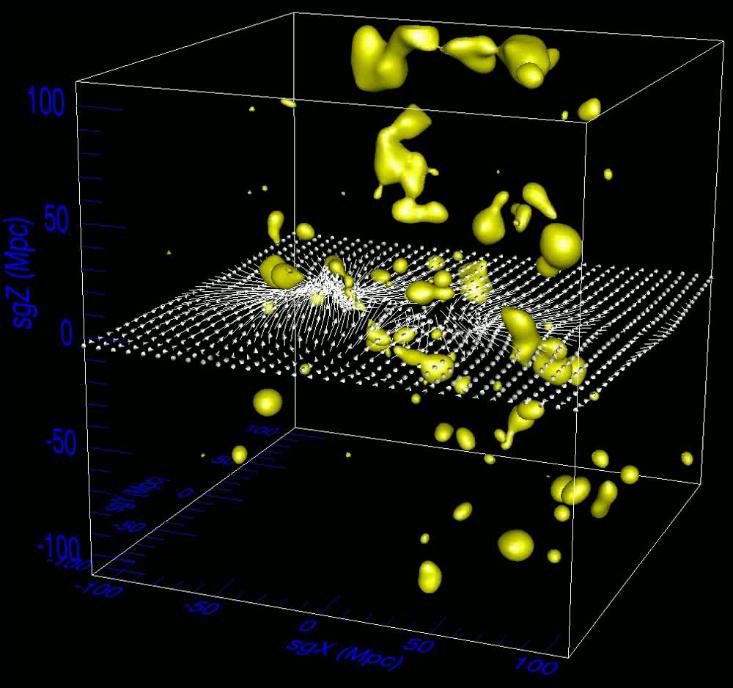
In the earliest moments after the Big Bang, the Universe was a turbulent mess, a high-temperature stew of quantum fluctuations. As with turbulence in water, the fluctuations acted at every level: If you could imagine observing the primordial chaos, at whatever level of magnification you used, from the tiniest to the largest, the cosmos was equally messy.
As the Universe expanded, turbulence smoothed out into uniformity. The homogeneity on all levels translated into nearly uniform density on the scale of the entire cosmos. But viewed on a smaller scale, in places where the amount of hydrogen gas happened to be slightly greater, the clumps coalesced into galaxies.
That’s according to the standard version of cosmology, but it’s not been proven beyond a doubt. An alternative view states that the turbulence didn’t get smoothed out at all, leaving us in a lumpy Universe. This inhomogeneous cosmos has regions of very high and very low density, of many sizes, and doesn’t appear smooth from any perspective.
Think of the standard version as the homogenized-milk cosmos, while the inhomogeneous alternative as an oil-and-vinegar dressing. The difference is one of scale, as we say in physics. On the macroscopic scale, milk is homogeneous, appearing to be a solid color and density. In a microscope, however, it is inhomogeneous, consisting of small fat globules suspended in the thinner, watery fluid. By contrast, vinaigrette dressing is inhomogeneous on every scale, macroscopic and microscopic—you can easily see the separate oil and water droplets.
Seeing as we’re pretty small compared with the Universe, our view of it is analogous to the microscopic view; from our tiny perch, it’s difficult to tell whether a god’s-eye view would show homogeneity or not. To test the principle requires mapping galaxies throughout a substantial fraction of the observable Universe, comparing their locations and motions. For example, the Milky Way and its neighboring galaxies in the Local Group lie on the outskirts of a region inventively known as the Local Void—a region with significantly lower density of matter than the average across the whole Universe.
If we were actually inside the Local Void without knowing it, we might be fooled into thinking the cosmos is more homogeneous than it actually is. That’s a testable hypothesis, with profound consequences if it’s true. To name just one, the accelerating expansion of the Universe that astronomers have observed—thought to be driven by the mysterious “dark energy”—might be entirely illusory. As the Universe expands, matter clumps together due to gravity, resulting in the rapid growth of voids between the clumps. If we’re inside a void in a lumpy Universe but think we’re in a homogeneous Universe, the growth of the bubble we’re in skews our measurements of distances to and speeds of galaxies far outside the void. If things are inhomogeneous, then our calibration is off, tricking us into making up this thing called dark energy.
Another side-effect of inhomogeneity is that different regions of space must expand at different rates, due to the warping effects of massive clumps of matter, so the recorded age of the Universe would vary from place to place. We measure 13.8 billion years since the Big Bang, but if the cosmos were inhomogeneous, an observer in a distant galaxy might record 18 billion years, or 13.5 billion. So an inhomogeneous Universe is much more complicated, but we can’t reject the idea just because it’s inconvenient for scientists without testing it. One way to do so involves mapping relatively nearby galaxies to gauge how empty a void we’re in.

One recent analysis of of 4,534 galaxies found that if we don’t assume homogeneity from the start, the evidence from observations actually points to a very lumpy cosmos. In fact, the study claimed that the lumpiness of the local Universe, and the way the uneven mass distribution alters light, is creating an illusion that the Universe’s expansion is accelerating.
It’s a controversial idea, and not everyone is ready to jump to the strongest conclusions. Indeed, it would be quite a shock—the accelerating expansion has become a standard part of modern cosmology, and the discovery earned a Nobel Prize for three researchers in 2011. Cosmologist Asantha Cooray of University of California, Irvine, has considered the inhomogeneity question as well, but he’s decidedly cautious. “In order to explain the dark energy or acceleration as measured now with supernovae data, one needs a void that is mostly empty—effectively no galaxies—out to [large] distances,” he told me.
But galaxy surveys like the 2-Micron All-Sky Survey (2MASS), show that the density of galaxies is only 25% less than average in our cosmic neighborhood. To be fooled into thinking dark energy is real when it’s not, the void we’re sitting in must be really huge to make up for the fact that it’s not that empty. The alternative is that we’re not fooled after all, the void we’re in isn’t that empty to start with, and the Universe is actually smooth.
As it happens, there are several good reasons to suspect the Universe is homogeneous on the largest scales. For one thing, it appears to be isotropic: essentially the same in all directions. The best evidence for isotropy is the cosmic microwave background, which shows the temperature of the early Universe was nearly the same in all directions and on all scales; careful measurements show the temperature varies by no more than one part in 10,000. Together, homogeneity and isotropy imply that there is nothing particularly special about our place in the Universe—or any other place. This idea is called the “cosmological principle.”
Homogeneity is harder to demonstrate than isotropy, but we’re aided by the fact that an isotropic cosmos must also be homogeneous (though the opposite isn’t necessarily true). But maybe the Universe has enough of the appearance of isotropy from our perspective to fool us, leading us to believe the cosmological principle when it ain’t so.
For the Universe to seem isotropic when it is not, we would have to occupy an unusual spot. If you stand on a tiny island, the ocean appears “homogeneous” (flat) and isotropic, but if you got on a raft, paddled away, and looked back at the island, you’d see it was neither. The island shows the ocean is neither homogeneous nor isotropic: It’s a special location, and a direction you can look where the elevation is greater than every other direction.
In our case, we see a broadly isotropic cosmos from here on Earth, reasonably assume we don’t occupy a special place in it, and infer the Universe is also homogeneous on the largest scales. But principles are not enough: We need evidence, and that requires measuring cosmic lumpiness. To truly test the homogeneity hypothesis, Cooray says, we need to probe galactic motion farther out than Wiltshire and colleagues did: “Till somebody completes that study, the idea that we live in a void and whether that can explain the acceleration will remain unsolved.” Only then will we know whether primordial turbulence melted away in the Universe’s youth, or was frozen into bubbles that persist in our cosmos.
Matthew Francis is a physicist, science writer, public speaker, educator, and frequent wearer of jaunty hats. He’s currently writing a book on cosmology with the working title Back Roads, Dark Skies: A Cosmological Journey.






























